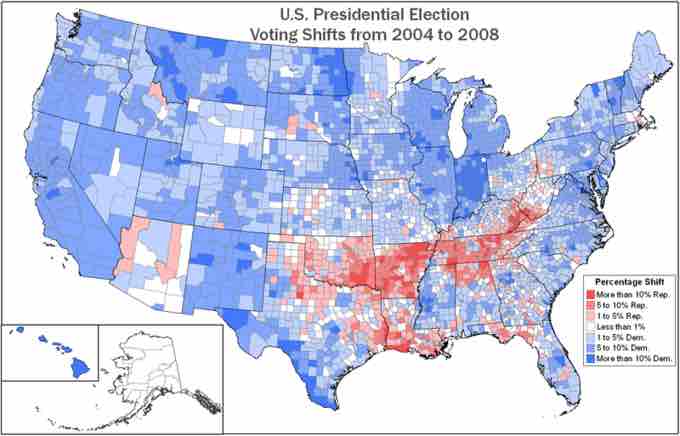Party Identification
Party identification refers to the political party with which an individual identifies. Party identification is typically determined by the political party that an individual most commonly supports, by voting or other means. shows the shift of party identification between the 2004 and 2008 presidential elections.

Voting Shifts by County Between the 2004 and 2008 Presidential Election
Voter identification is shown no where more clearly perhaps than during presidential elections. This map shows shifts in broad county party identification between the 2004 and 2008 presidential elections.
In the United States, political parties consist of three parts: the party as government (members of the party who hold public office), the party as organization (committees, leaders and activists who work to promote the party and the candidates), and the party as electorate (citizens who support the party through party identification).
Citizens in the general population who identify with a particular party make up the Party in the Electorate. Party identifiers (partisans) could be described by their support in the following ways:
- They register as a member of the particular party when registered to vote.
- They show a strong tendency to vote for candidates in their preferred party in most elections.
- When surveyed, they identify themselves as members of that particular party.
- They are inclined to support policies endorsed by the particular party.
- They volunteer for campaigns to support party candidates more than the general population.
- They have a higher voter turnout in primary elections than the general population.
Some researchers view party identification as a form of social identity, in the same way that a person identifies with a religious or ethnic group. This identity develops early in a person's life mainly through family and social influences. This description would make party identification a stable perspective, which develops as a consequence of personal, family, social and environmental factors. Other researchers consider party identification to be more flexible and more of a conscious choice. They see it as a position and a choice based on the continued assessment of the political, economic and social environment. Party identification can increase or even shift by motivating events or conditions in the country.
Characterization
Childhood influence
Childhood Influence is one of main driving factors behind formation of party identification. During childhood, the main political influence comes from parents, other close family members and close surroundings such as the immediate community. Children remember events that happened during their childhood and associate them with the political party, whether or not they were connected with those events. For example, a child growing up in the 1970s would associate the Republican party with the Watergate scandal of the Nixon administration, a child growing up in the 1990s would associate the Democratic party with the sex scandal of the Clinton administration, or a child growing up in early 2000 would associate the Republican party with the Iraq War and the War on Terror. Although these parties might or might not embrace the issues that happened during that administration, a child could forever associate the party with those memorable events.
Adulthood
During adulthood, people can begin to adjust their party loyalties according to their personal experiences. The longer an individual holds a party ID, the stronger that attachment to the party tends to become. Because of this, older adults are more likely to hold strong party attachments, and less likely to change them than young adults.
Change
Party ID changes can occur in times of party coalition change, or realignment. During these times, party coalitions themselves are being transformed, and as a result, people are more likely to desert the party of their parents. It is during these times of partisan turmoil when younger adults are more likely to change party ID.
Measuring Party Identification
It is important to measure party identification in order to determine its strengths and weaknesses. Political scientists have developed many ways to measure party identification in order to examine and evaluate it.
One method of measuring party identification uses the Likert Scale. The Likert Scale is a 7 point scale to measure party identification:
Strong Democrat-Weak Democrat-Lean Democrat-Independent-Lean Republican-Weak Republican-Strong Republican
This scale does have some problematic aspects. According to the scale, a weak party supporter should normally vote with the party, but many times this is not the case. A "leaning" party supporter shows more loyalty to the party than that of a weak party supporter. Weak party supporters are more likely to stray from their party than someone who does not really declare a party identification and only tends to lean to one or the other based on the issues at hand.
Voting
Those people who identify with a party tend to vote for their party's candidate for various offices in high percentages. Those who consider themselves to be strong partisans, tend to be the most faithful in voting for their party's nominee for office. In the case of voting for president, since the 1970s, party identification on voting behavior has been increasing significantly. By the late 1990s, party identification on voting behavior was at the highest level of any election since the 1950s. When voting in congressional elections, the trend is similar. Strong party identifiers voted overwhelmingly for their party's nominee in the general election.
The same level of voting behavior can also be applied to state and local levels. While straight ticket voting has declined among the general voting population, it is still prevalent in those who are strong Republicans and strong Democrats.